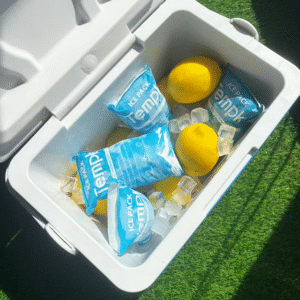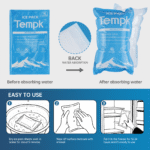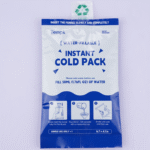Shipping perishable items requires precise temperature control. Dry ice packs next day delivery is one of the best solutions to ensure your products reach their destination safely and on time. Whether you’re shipping frozen food, medical supplies, or other temperature-sensitive products, understanding the role of dry ice is essential for optimizing your shipping operations.
-
What is dry ice packs next day delivery, and why is it crucial for temperature-sensitive shipments?
-
How do dry ice packs maintain product integrity during shipping?
-
What are the best practices for using dry ice in next day shipping?
-
How can businesses manage costs while ensuring the safe delivery of their goods?
What Is Dry Ice Packs Next Day Delivery?
Dry ice packs next day delivery refers to using dry ice as a cooling agent for shipping perishable products with a guaranteed delivery time of 24 hours. Dry ice, or solid carbon dioxide, sublimates at a temperature of -78.5°C (-109.3°F), maintaining extremely low temperatures and ensuring that your products remain frozen throughout the shipping process.
Why Choose Dry Ice for Next Day Delivery?
-
Efficient Cooling: Dry ice keeps your products at sub-zero temperatures for extended periods.
-
Reliable Delivery: Ensures that products arrive on time and in optimal condition.
-
Safety: Properly handled dry ice is safe for shipping food, pharmaceuticals, and biological samples.
The Science Behind Dry Ice in Shipping
Unlike traditional ice, which melts and becomes water, dry ice sublimates directly from solid to gas, absorbing heat in the process. This feature is critical for temperature-sensitive shipments, as it doesn’t introduce moisture into the packaging. Next day delivery using dry ice ensures that your items remain frozen and intact.
| Feature | Description | Practical Significance |
|---|---|---|
| Sublimation | Directly turns from solid to gas | Maintains cold without moisture or melting issues |
| Non-toxic | Made from carbon dioxide | Safe for food and biological shipments |
| High effectiveness | Keeps goods frozen for up to 24 hours | Ideal for next day or long-distance shipping |
Best Practices for Using Dry Ice in Next Day Shipping
Step 1: Proper Sizing of Dry Ice Packs
Choosing the right amount of dry ice is crucial for maintaining optimal temperature conditions. To calculate the required amount, consider:
-
Shipping duration: How long will the package be in transit?
-
Package size: Larger shipments need more dry ice.
-
External conditions: Hotter climates will cause dry ice to sublimate faster.
For smaller packages, use 5-10 pounds of dry ice, and adjust based on specific needs.
Step 2: Use Insulated Packaging
Insulated containers made of materials like Styrofoam or vacuum-sealed bags are essential for slowing down the sublimation of dry ice, ensuring your products remain frozen during transit. For next day shipping, proper insulation is essential.
Step 3: Monitor Shipment Temperature
Using temperature-sensitive shipping tools helps track the internal temperature of the shipment. Many services now offer real-time tracking, allowing you to monitor the effectiveness of dry ice during transit and ensure that products remain within the necessary temperature range.
How to Manage Costs with Dry Ice Packs Next Day Delivery
Shipping with dry ice can be more expensive than traditional methods, but the benefits outweigh the costs in terms of reducing spoilage and ensuring customer satisfaction. Here are some tips to manage shipping costs:
-
Optimize package size: Use only the amount of dry ice necessary to ensure safe delivery, minimizing costs without compromising quality.
-
Choose reliable shipping providers: Work with logistics companies specializing in temperature-controlled deliveries to avoid delays and extra fees.
-
Consolidate shipments: Bundle shipments to reduce overall shipping costs.
FAQ: Frequently Asked Questions
Q1: How long does dry ice last during next day shipping?
Dry ice typically lasts 18-24 hours, depending on package size, external temperatures, and insulation. For next day delivery, this timeframe is generally sufficient.
Q2: Can dry ice be used to ship food?
Yes, dry ice is commonly used for shipping frozen food, ensuring it remains at the proper temperature during transport.
2025 Trends in Dry Ice Shipping
As we approach 2025, innovations in dry ice shipping are transforming the logistics industry. Advancements like smart packaging technologies and real-time temperature monitoring systems are becoming commonplace, allowing businesses to guarantee the safety of their products during transit.
Latest Developments
-
Smart Packaging: This revolutionizes how businesses send temperature-sensitive items by integrating sensors that track temperature fluctuations.
-
Eco-friendly Alternatives: The industry is moving toward more sustainable practices, including the use of bio-based CO2 production and hybrid cooling solutions.
Conclusion
To summarize, dry ice packs next day delivery is essential for businesses shipping temperature-sensitive goods. By choosing the right amount of dry ice, using proper packaging, and following best practices, you can ensure the safe and timely delivery of perishable items.
Next Steps for Your Business
-
Review your shipping practices: Ensure that dry ice is integrated effectively into your shipping processes.
-
Train your staff: Proper training is crucial to mitigate risks and improve product handling.
-
Explore partnerships: Work with logistics providers that specialize in cold chain shipping for optimal results.
About Tempk
At Tempk, we specialize in providing cold chain logistics solutions tailored to your needs. With a focus on innovation and quality, our services ensure the safe and efficient delivery of temperature-sensitive products. Let us help streamline your shipping operations.
Consult with Tempk today to optimize your dry ice shipping strategy!
























